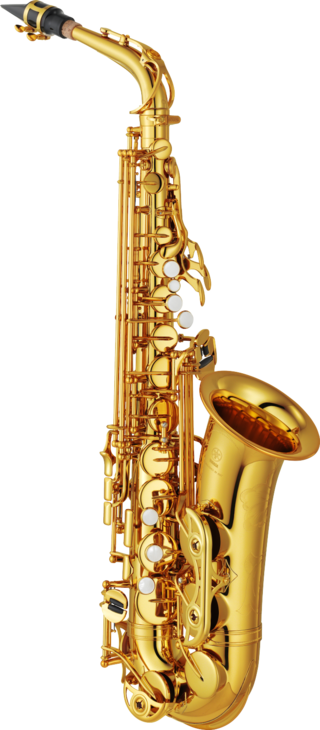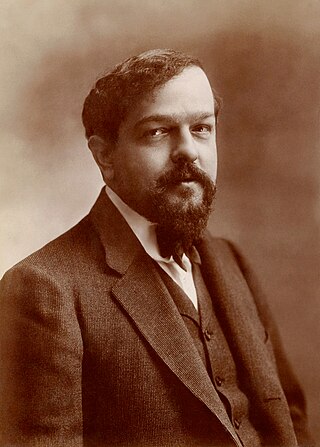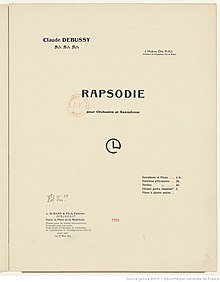A rhapsody in music is a one-movement work that is episodic yet integrated, free-flowing in structure, featuring a range of highly contrasted moods, colour, and tonality. An air of spontaneous inspiration and a sense of improvisation make it freer in form than a set of variations.

Esa-Pekka Salonen is a Finnish conductor and composer. He is the music director of the San Francisco Symphony and conductor laureate of the Los Angeles Philharmonic, Philharmonia Orchestra in London and the Swedish Radio Symphony Orchestra.

André Caplet was a French composer and conductor of classical music. He was a friend of Claude Debussy and completed the orchestration of several of Debussy's compositions as well as arrangements of several of them for different instruments.

The alto saxophone is a member of the saxophone family of woodwind instruments. Saxophones were invented by Belgian instrument designer Adolphe Sax in the 1840s and patented in 1846. The alto saxophone is pitched in the key of E♭, smaller than the B♭ tenor but larger than the B♭ soprano. It is the most common saxophone and is used in popular music, concert bands, chamber music, solo repertoire, military bands, marching bands, pep bands, carnatic music, and jazz.
Children's Corner, L. 113, is a six-movement suite for solo piano by Claude Debussy. It was published by Durand in 1908, and was first performed by Harold Bauer in Paris on 18 December that year. In 1911, an orchestration by André Caplet was premiered and subsequently published.
Suite bergamasque is a piano suite by Claude Debussy. He began composing it around 1890, at the age of 28, but significantly revised it just before its 1905 publication. The popularity of the third movement, Clair de lune, has made it one of the composer's most famous works for piano, as well as one of the most famous musical pieces of all time.
Désiré-Émile Inghelbrecht was a French composer, conductor and writer.

Charles-Louis-Eugène Koechlin, commonly known as Charles Koechlin, was a French composer, teacher and musicologist. Among his better known works is Les Heures persanes, a set of piano pieces based on the novel Vers Ispahan by Pierre Loti and The Seven Stars Symphony, a 7 movement symphony where each movement is themed around a different film star who were popular at the time of the piece's writing (1933).

Henri Benjamin Rabaud was a French conductor, composer and pedagogue, who held important posts in the French musical establishment and upheld mainly conservative trends in French music in the first half of the twentieth century.

Paul Henri Büsser was a French classical composer, organist, conductor and teacher. Among his teachers were César Franck, Charles Gounod and Jules Massenet. In addition to his own compositions Büsser edited and orchestrated a wide range of music – mostly but not exclusively French – dating from the 17th to the 20th centuries. He was at various times in his career the conductor of the Paris Opéra and the Opéra-Comique, and professor of composition at the Conservatoire de Paris.

Images pour orchestre, L. 122, is an orchestral composition in three sections by Claude Debussy, written between 1905 and 1912. Debussy had originally intended this set of Images as a two-piano sequel to the first set of Images for solo piano, as described in a letter to his publisher Durand as of September 1905. However, by March 1906, in another letter to Durand, he had begun to think of arranging the work for orchestra rather than two pianos.

Jean Jules Aimable Roger-Ducasse was a French composer.

Lucien Durosoir was a French composer and violinist whose works were rediscovered thanks to manuscripts found by his son Luc. Durosoir studied the violin with Joseph Joachim and Hugo Heermann in Germany before his first tour as a young virtuoso in 1899. In addition to giving the first performances of French music in Austria-Hungary and Germany, he also gave the French premiere of the Strauss violin concerto in 1901. His career as a violinist was cut short by World War I. Durosoir served in the Fifth Division, which took part in some of the bloodiest battles of the war. At the encouragement of General Mangin, Durosoir formed a string quartet with his fellow soldiers Henri Lemoine, André Caplet (viola), and Maurice Maréchal (cello).

Berceuse, Op. 16, is a short piece by Gabriel Fauré, written in or about 1879. In its original version it is for solo violin and piano. The composer later published a version for violin and orchestra, and the work has been arranged by others for various musical forces. This berceuse is not connected, except for its title, with the berceuse in Fauré's Dolly Suite.

Le Martyre de saint Sébastien is a five-act musical mystery play on the subject of Saint Sebastian, with a text written in 1911 by the Italian author Gabriele D'Annunzio and incidental music by the French composer Claude Debussy (L.124).
The Première rhapsodie, L. 116, CD. 124, by Claude Debussy is a piece for accompanied clarinet. Composed between December 1909 and January 1910, it was dedicated to the French clarinet professor Prosper Mimart.

Elise Hall was one of the first prominent female saxophonists in the United States. She founded the Boston Orchestral Club.
Introduction and Allegro for Harp, Flute, Clarinet and String Quartet is a chamber work by Maurice Ravel. It is a short piece, typically lasting between ten and eleven minutes in performance. It was commissioned in 1905 by the Érard harp manufacturers to showcase their instruments, and has been described as a miniature harp concerto. The premiere was in Paris on 22 February 1907.

The Fantaisie for piano and orchestra, Op. 111, is a concertante composition written by Gabriel Fauré in 1918.













